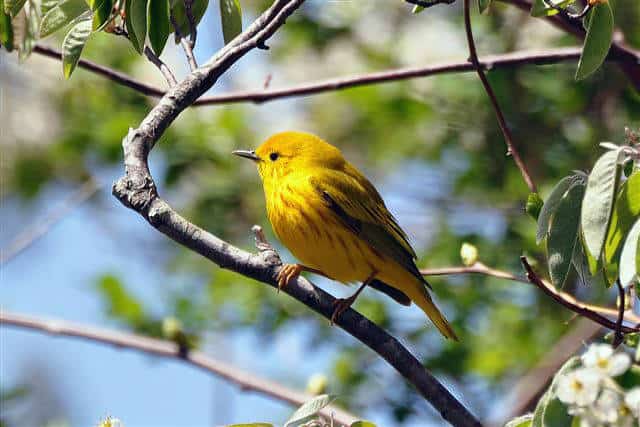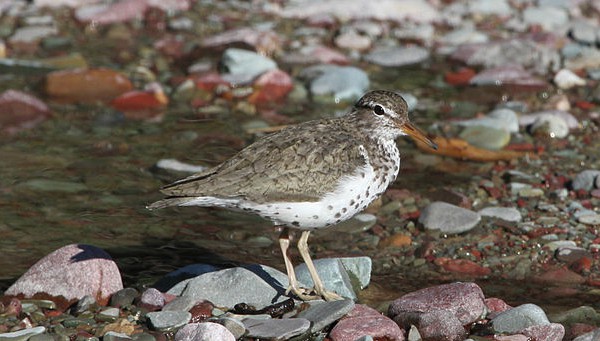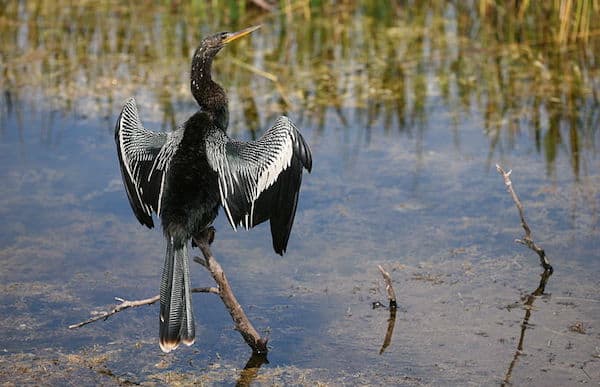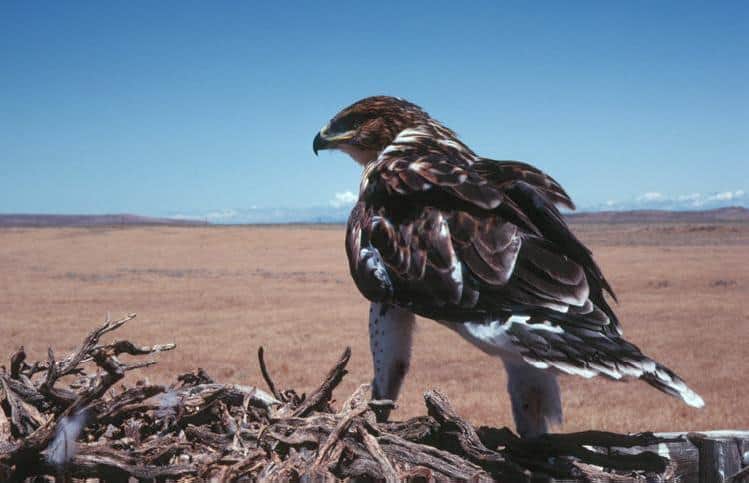Millions of us who love birds know at least a bit about John James Audubon, perhaps the greatest birder of them all, and most of us are familiar with the Audubon Society, one of our leading national conservation organizations. Strange, then, that relatively few folks have visited or even heard about Audubon State Park in Henderson, Ky.
The park comprises 692 heavily wooded acres along U.S. Highway 41 North in Henderson, a vibrant small city in Western Kentucky across the Ohio River from Evansville, Ind. It boasts one of the world’s largest collections of Audubon’s original oils, watercolors, engravings and memorabilia. You’ll find the Audubon Museum and Nature Center housed in an impressive building whose French Norman architecture pays tribute to the great naturalist’s ancestry. Constructed with birds in mind, the museum tower’s exterior even includes small niches to accommodate nests.
Don’t worry about having to battle a crowd. Park Manager Mary Dee Miller reports that while several hundred thousand persons visited the park in 2002, only 9,000 of them paid a modest sum to tour the museum and nature center. That’s really a shame. My wife Ellen and I found our trip through the facility both entertaining and educational. We found it to be an absolute “must” for any serious birder.
Audubon (1785-1851), the first artist to depict life-size birds and animals in their natural surroundings, lived in Henderson from 1810 to 1819, having been lured there by its proximity to the Mississippi Flyway. The flyway funneled millions of birds north each spring and south in the fall, assuring a large variety of specimens to draw and paint. It still does.
Many neotropical species spend the summer nesting and raising their young in this richly forested region, remnants of whose hardwoods comprise the state park. Warblers, in particular, find the surroundings to their liking. It’s an enjoyable challenge to identify as many of the warblers that inhabit the park in the spring and summer as you can; more than 20 species nest there. In all, over 200 species of birds have been seen in the area, along with at least 40 kinds of mammals, reptiles and amphibians and an estimated thousand varieties of flowering and non-flowering plants.
To see many of these, take your binoculars and head out for an exploratory hike along the park’s five and one-half miles of trails. Surrounded by deep, often damp, woods and a myriad of bird calls, you’ll quickly forget that “civilization” lies just a few minutes away.
But first things first, and that means a visit to the museum where you’ll find Audubon’s original works and personal artifacts, including correspondence, journals, and ledgers, filling four galleries. There’s a diorama featuring a lifelike image of the talented artist at work in a studio filled with his personal effects. Also displayed are a complete collection of Audubon’s publications, including an intact four-volume edition of the “Birds of America,” and a life storyline that illustrates the contributions made by his wife Lucy and his sons toward completion of his work.
Interactive best describes the adjoining nature center’s discovery room which features hands-on activities and educational exhibits for kids of all ages. That’s where Ellen and I caught up with a visiting class of 10-year-olds on a field trip. Some of the major displays focus on bird locomotion, feeding, habitat and behavior.
One boy seemed deeply engrossed in viewing a mounted bobcat with a bird in its mouth. “That’s kind of gross, isn’t it?” Ellen asked the youngster. “Nah,” he replied with a broad grin, “it’s cool!” Ah, to be young again.
Another component of the nature center is its binocular-equipped wildlife observatory. This circular room utilizes floor-to-ceiling windows that overlook a native plant garden and a woodland pond. The native plants and the water source combine with well stocked feeders for both seed-eaters and hummingbirds to attract an endless stream of feathered visitors just outside the windows. All of this creates an up-close-and-personal nature experience guaranteed to please any bird lover.
At the learning center, a terraced outdoor patio next to the museum and nature center, Ellen and I again crossed paths with the visiting school kids. They were entranced by park naturalist Brian Gasdorf who was displaying a captive injured red-tailed hawk while discussing its habits and those of raptors in general. When the chance came, the fascinated children peppered Gasdorf with questions. The bird seemed to get into the spirit of the moment, spreading its impressive wings and checking us out with beady eyes. This was entertaining stuff, to be sure, but equally important it was a meaningful educational experience for everyone.
The show over, we moved back inside to chat with museum employees and spend a few dollars in the well stocked gift shop. We topped off the day with a hike, enjoying not only the flitting, colorful birds but also the deep upland forest sprinkled with eye-catching giant oaks, beech, and tuliptrees.
John James Audubon and the birds he loved and painted clearly claim center stage at this remarkable place, but they’re not the only diversions. Other activities in the park include tennis; picnicking; photography; golf on a beautifully manicured nine-hole course; swimming, boating, and fishing in a 28-acre lake; and hiking on trails that range from paved to rugged. You can camp (the park maintains 69 trailer and tent sites) or rent one of the six fully equipped cottages and live among the birds, the white-tailed deer, and the other critters that make their home in this peaceful forest-within-a-city.
Audubon State Park traces its roots back to 1934 when Henderson librarian Susan Towles led efforts to procure land and document the historic significance of the site in order to see her dream of a park honoring the artist come true. Audubon had been friends with Towles’ grandfather when he lived in Henderson.
Some 200 members of the federal government-sponsored Civilian Conservation Corps (CCC), working with the help of locals and Works Progress Administration (WPA) personnel, spent four years draining swamps, developing trails, and constructing buildings, including the museum, at a cost of $500,000.
Alice Tyler, widow of Audubon’s great–grandson Leonard Tyler, maintained contact with Towles during construction of the park. When it was completed in 1938, she transferred her large personal collection of Audubon materials from the Peabody Museum at Yale University to Henderson. The park museum opened July 16, 1938. New lighting was installed in the early ‘50s. In 1992, a $2.5 million renovation that included addition of the 9,500-square-foot nature center took place.
Today, Audubon’s influence extends beyond the park into downtown Henderson where Audubon Mill Park has been constructed on the banks of the Ohio River. A historic marker there calls attention to the steam-powered saw and grist mill Audubon built at the location in 1816. A plaque informs visitors that the business failed three years later. An embittered Audubon referred to the venture as “that infernal mill.” Having lost $15,000 and with a destitute family, he left Henderson to make a fresh start–one focused on art– and, ultimately, to find fame as the world’s leading painter of birds and animals.
Other plaques bear witness to that success, telling us that the U.S. House of Representatives subscribed to his “Birds of America” pictures, as did such well known persons of the time as Daniel Webster, John Jacob Astor, and Washington Irving. President Andrew Jackson promised Audubon use of a government vessel for a birding expedition.
Audubon Mill Park is an inviting spot for locals and visitors alike. You can rest on a bench, enjoy a sack lunch, and watch the mighty Ohio roll by. A variety of chattering birds flit through the park’s tall trees, sometimes skimming low over the water in search of their own lunch. You can learn about Henderson’s other famous former residents by reading plaques along the riverbank. Commemorated are W.C. Handy, “Father of the Blues,” who lived in Henderson from 1892 to 1903, and four past governors of Kentucky, including A.B. “Happy” Chandler, who also served for a time as commissioner of Major League Baseball.
Audubon’s presence in downtown Henderson is further enhanced by eight beautiful life size bronze bird sculptures. Created by Louisville, Ky., sculptor Raymond Graf, the three-dimensional pieces are based on original Audubon paintings, including his signature wild turkey which also adorns the sign at the state park entrance. Others include a great blue heron, an osprey, an ivory-billed woodpecker, a pigeon hawk, a kingfisher, purple martins, and hooded mergansers.
If you can stay away from the state park long enough, you’ll want to partake of Henderson’s delightful historic walking tour. It showcases 36 buildings ranging from pre-Civil War architecture to Victorian structures built at the close of the 19th century. The town’s once thriving trade in dark tobacco financed construction of a surprisingly large number of expensive homes. You’ll find plenty of restaurants, boutiques, specialty shops, and antique dealers to keep you busy for a day.
Getting back to birding, though, you should know that Audubon State Park isn’t the only haven for feathered visitors in the Henderson area. Take time to enjoy a visit to the Sloughs State Wildlife Management Area, which encompasses nearly 10,000 acres of wetlands, woods, ridges, and open fields. During the winter, it supplies refuge for 30,000 Canada geese and 10,000 ducks.
Open to the public mid-March through mid-October, Sloughs provides observation platforms along Highway 268 a few miles southwest of the city. Because the platforms are just outside the refuge, they are open year ‘round. The area is especially known for its rails and marsh-loving species of sparrows and wrens. You’ll probably see herons, egrets, warblers, and a mix of other species, too.
Now, if Audubon State Park and Sloughs Wildlife Management Area have whetted your appetite, and if you’ve got the time, you’ll want to hop in the car and investigate one or more of Western Kentucky’s four exciting birding trails. You can obtain maps and descriptive brochures at the Audubon museum before you head out. Start, logically, with the Audubon Trail. This 60-mile loop incorporates the state park and Sloughs, but it also offers other gems including Jennyhole-Highland Creek where you’ll find Kentucky’s largest great blue heron rookery.
The Ballard Trail, another 60-mile loop, begins in Paducah and takes you to not one or two, but four, wildlife management areas: West Kentucky, Ballard County, Pearl, and Swan Lake. On this tour, you’ll see cypress swamps, marshlands, woods, and prairie remnants, as well as a plethora of bird species ranging from flycatchers and woodpeckers to hawks and bald eagles.
In Princeton, pick up the Pennyrile Trail, at 75 miles the longest of the four birding loops. On this leg, you’ll see three more wildlife management areas (Jones-Keeney, Tradewater, and White City) as well as the Pennyrile State Forest where you can enjoy the lodging and dining amenities offered at Pennyrile Forest State Resort Park. Much of the terrain in this area is especially scenic, featuring bluffs, rock overhangs, and small caves in addition to heavy mixed stands of trees in the state forest. In contrast, White City Wildlife Management Area displays reclaimed minelands, bottomland forests, and open fields. The variety of birds is as diverse as the habitat.
Finally, travel the 60-mile-long Trace Trail. Beginning at Kentucky Dam, this route traverses the federally managed Land Between the Lakes area in Kentucky and south into Tennessee where it connects with the Western Highland Rim Automobile Birding Trail in Dover, Tenn. At Kentucky Dam, you will see several species of gulls, ospreys in summer, white pelicans, great blue herons, and several kinds of swallows. This trip also features a 750-acre elk and bison prairie where you can watch those regal reintroduced animals grazing on native grasses. Birds there run the gamut from vultures and wild turkeys to eastern bluebirds, meadowlarks, and numerous species of sparrows.
Yes, they’re all here in Henderson and across Western Kentucky. Neotropical migrants, wading birds, shore birds, raptors. You name it, and it’s likely to be found in this scenic region. John James Audubon knew that. Now, we all know it!
For More Information
Check out the Audubon State Park website at www.kystateparks.com or call the park at (270) 826-2247. Mailing address is P.O. Box 576, Henderson, KY 42419-0576. The Henderson County Tourist Commission can reached by phone at 1-800-648-3128 and maintains a website at www.hendersonky.org.




